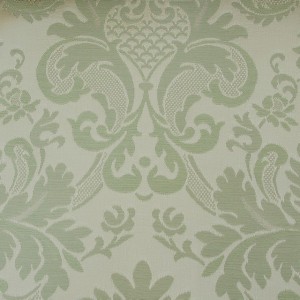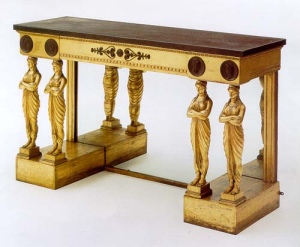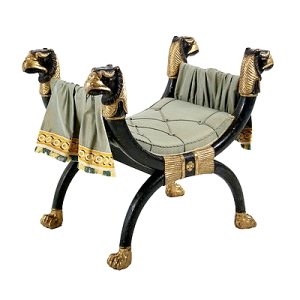You may have read my last blog post where I wrote about key things to look for when buying a piece of Georgian or Georgian style furniture to add to your home. In this post I will be exploring the Regency style furniture and it’s traits.
Overview
Furniture during the Regency period was Neo-classical in style, along with the Empire style which was also fashionable at the time. Neo-Classical furniture takes inspiration from and revives classic elements from classic Greece, and the Empire style was based on aspects of the Roman empire and its many archaeological treasures. Essentially the Regency style of furniture was all about classic flamboyance and more than a touch of the exotic. Pieces often combined elements of Egyptian, Gothic and Chinese motifs.
Materials
The materials used were very similar to the Georgian period (oak, mahogany, walnut and burr walnut) with Regency also adding new foreign woods to feed the increasing demand for colour such as Rosewood and yellow-white Satinwood as well as rarer tulipwood and zebrawood (the expense of zebrawood confined its use to veneers and lattice or string work). Lead and brass was also used for door handles and marble was being revived in the Regency for tabletops. Cheaper wood (pine, fir, beech) was painted during the period, often green and dusted with bronze coloured metal powder to achieve the effect of patinated antique bronze.
Design
Regency furniture was classic and elegant. Typical pieces include tilt-top dining tables, double sabre leg chairs and pedestal sideboards. Rosewood and zebrawood veneers were used for a striking look, whilst brass and gilt were used to pick out finer decoration.
Some characteristics of the regency period were Sabre legs (curved chair leg which resembles the line of a sabre blade), reeding (a technique wherein “reeds” are carved or milled into a surface) and lion paw feet, as seen in the first post.
Regency chairs were usually low with curved backs, sabre legs and brass inlays. Caned seating, as seen above, was quite common, as well as squab cushioning. Furniture was often upholstered with leather for library and dining chairs, and satin and damask for sofas. Rich chintzes were often used, with the main motif featured on the back of the chair. It was also fashionable for chairs and sofas to be upholstered in the same colour as curtains.
In the Regency period it become very fashionable to have at least one or two sofas in a room. Most sofas in the Regency were very large and had several loose cushions along the back with a bolster at each end.
Well known and influential designers of this period were Thomas Hope, George Smith, and Henry Holland.
Henry Holland
Henry Holland was attributed to being the Regency’s most prominent architect-furniture designer. Holland’s work shows two distinct traits, a strong chinoiserie style (Chinoiserie, a French term, signifying “Chinese-esque”, refers to a recurring theme in European artistic styles since the seventeenth century, which reflect Chinese artistic influences) and his Francophile Classical style. Both of these styles are favourites of mine. Whereas the heavier Egyptian and Greek styles can be too much for many of todays interiors.
Thomas Hope Style
Much of Thomas Hope’s pieces were designed with great influence from the Egyptian and Greek style. Hope’s far reaching travels across the world on his grand tour from Europe to Turkey and Egypt sparked his interest in antiquities as an inspiration for his furniture design and Regency interiors.
Hope’s style influenced the Regency Revival of the 1920s and ’30s, and even Art Deco design.
George Smith Style
George Smith an Egyptologist in his early career, was understandably an enthusiast for the new Egyptian style. Smith drew on French and Classical sources and combines with the earlier design styles of Sheraton and Hope. His use of motifs such as the griffin, sphinx, lion, leopard and palm leaves all added to the unique manner of his furniture.
Cost
I spoke on cost in my post on spotting Georgian furniture, and the same rules apply to the Regency period.
My favourites!
If I could only pick one piece of furniture from the Georgian/Regency periods it would be the Regency Chaise as my all time favourite. A Regency chaise can be so elegant and stylish and covered in beautiful fabric makes the perfect statement piece.
My favourite wood would have to be walnut for its richness and character closely followed by Rosewood. I love furniture to have curves and a graceful form. Too much fuss and intricacy can ruin a piece although there are some exquisite examples of chinese inspired furniture form the period that contradict that rule for me.
I hope this blog has helped you to understand a little more on some typical Regency style pieces. They are beautifully and expertly made and can compliment any home setting. Personally, I find them a lot more interesting than cheap, mass produced goods of today. To see how I have used classic pieces in modern homes, feel free to have a look at my website, which specialises on Georgian and Regency interior design.

















Hi! Can I send you a picture of a chair to see if you can tell me if its from the Regency period? Thank you!
Hi there
You can email me the photo on sarah@lathaminteriors.co.uk and I will try to assist. Perhaps you can give me any background you have on the chair. Where and when did you get it for example?
Kind regards
Sarah
Hi,
Just wondering how you can tell a piece is the real deal or just a reproduction? Is it to do with the joinery?
Hi Lindell,
The joinery will tell us whether it is handmade or machine made but its also often to do with the type of wood used and any signs of genuine wear and tear through the ages rather than a pseudo distressed look. There are however some very high quality reproduction pieces that are hand made and that will be just as good quality os an original.
I hope this helps
Sarah
Hi. I also have a piece I’m trying to identify. Am I able to send you a pic at the above address? Thanks
Yes please do and I will see what I can tell you. Close up as well as full shots please.